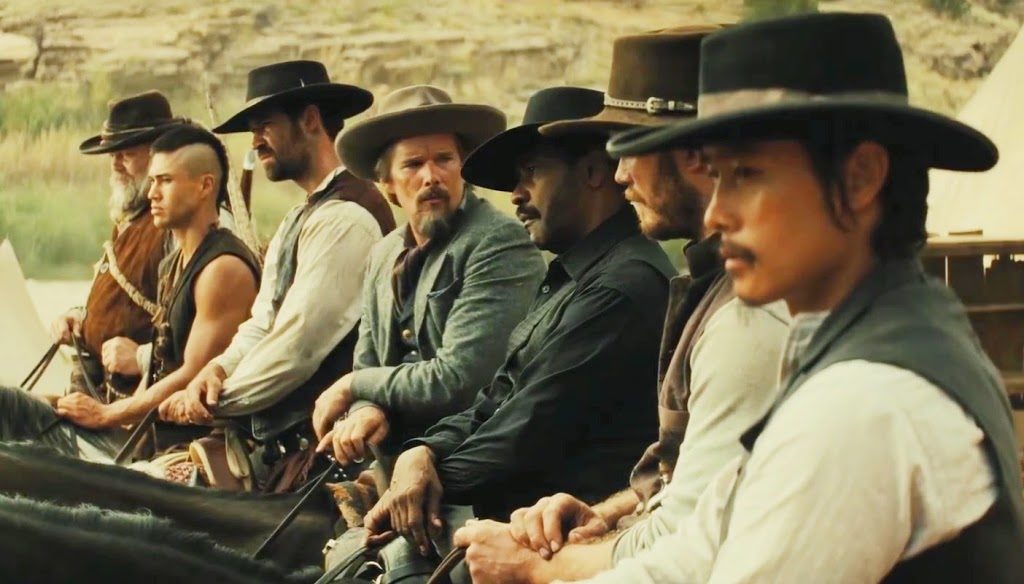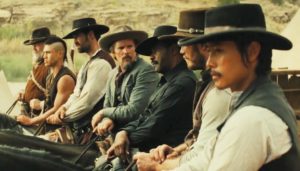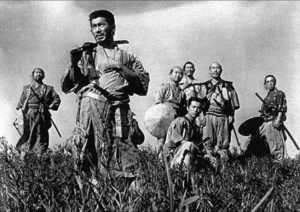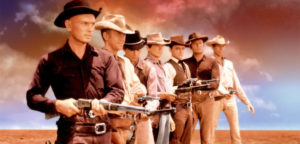Coluna Claquete – September 26th, 2016 – Movie of the Week: “The Magnificent Seven”
Newton Ramalho
colunaclaquete@gmail.com – www.colunaclaquete.blogspot.com– @colunaclaquete
Movie of the Week: “The Magnificent Seven”
Team that is winning nobody changes. Although this saying comes from football, the cinema incorporated it to the extreme, because remakes and a copies of a famous film will always have a good box office, even if by curiosity. Despite its own merits, this is exactly the case of “The Magnificent Seven” (2016).
To many people the current movie, starred by Denzel Washington, is just the remake of the eponymous film of 1960, which brought together some of the biggest stars in Hollywood at that time. In fact, both were based on the best known film of Japanese director Akira Kurosawa, “Seven Samurai” (“Sichinin the Samurai”).
The Japanese film, released in 1954, told the story of a small village in Japan of the sixteenth century, which had the threat of attack from a group of brigands, after the harvest period.In desperation, the villagers asked for help to Kambei (Takashi Shimura), a ronin, a samurai without a feudal leader. Touched by the situation of the village, Kambie seeked the help of other warriors like him, with no place in the closed Japanese society because they have no more a master. The newcomers had to deal with the suspicion of the locals, as well as training them to face the bad guys in a wild battle that would reap many lives.
Kurosawa’s film had a great impact in the world, even if getting only two Oscar nominations (Art Direction and Costume Design) and three for the BAFTA (Best Film and Foreign Actor to Toshiro Mifune and Takeshi Shimura), winning the Silver Lion of the Venice Film Festival.
Six years later, it was released “The Magnificent Seven” (1960), bringing together the cream of the stars of Hollywood’s action movies: Yul Brynner, Steve McQueen, Charles Bronson, Robert Vaughn, James Coburn and Eli Wallach. The film was directed by John Sturges, veteran in westerns and action films, like “Last Train from Gun Hill”, “Gunfight at the O.K. Corral”, “Never So Few”, and “The Old Man and the Sea”.
The story moved to Mexico, where a small town is threatened by the gang led by Calvera (Eli Wallach). Some residents crossed the border to seek help, finding it in Chris (Yul Brynner) and Vin (Steve McQueen). They were two unemployed gunmen who decide to help, not for money but for the adventure, and united other five outlaws.Here too there was doubts and suspicions, but the union prevailed in a terrible and bloody battle against the men of Calvera.
The film was a huge success and spawned a television series of the same name, with Robert Vaughn, one of the film’s actors, and three sequences, “Return of the Seven” (1966), “Guns of the Magnificent Seven” (1969) and “The Magnificent Seven Ride” (1972). The same idea was used in many movies, not only westerns but war, medieval, science fiction, and even the famous animated film “A Bug’s Life”, from Pixar/Disney.
In the current movie, the plot is set in a small rural town where there is a gold mine. The owner of the mine, Bartholomew Bogue (Peter Sarsgaard) is not satisfied with his possessions, wanted the property of everything in the region, including the farms around the village.To demonstrate the seriousness of his intentions, he does not hesitate to kill in cold blood unarmed men and women. Finally, he informs that within three weeks he will be back to take possession of it.
Angry with her husband’s death, Emma Cullen (Haley Bennett) decides to seek for help. With the little money they can collect in the city, she goes in search of gunmen to fight against Bogue. The chance leads her to Sam Chisolm (Denzel Washington), who decides to accept the challenge, calling other strange men: Josh Farraday (Chris Pratt), Goodnight Robicheaux (Ethan Hawke), Billy Rocks (Byung-Hun Lee), Jack Home (Vincent D’Onofrio), Vasquez (Manuel Garcia-Rulfo) and the native Red Harvest (Martin Sensmeier).Knowing that the task was almost impossible to seven men only, they need to convince people to fight, training them to do so.
It is curious how the films portrayed the historical moments of the time they were made. “Seven Samurai”, released just nine years after the end of World War II, shows a totally marginal world, but where people lived and died by the best values of Japanese culture. The despised class of the villagers is saved by ronins, dishonored samurais, that fighted for what they considered right.
In the 1960’s version, the heroes were white and American, while the bad guys were Mexicans.It was odd that even the Mexican member of the group had all the physical characteristics of a Caucasian.Trump would be happy with this release.
In the current version, poetic liberties were taken, as well as “politically correct”. The group is more diverse, and among the seven members of the group there are one native, one mexican, one asian and one black, who is the leader of the pack. The villain is no longer a rude Mexican, but a white capitalist. The oppressed people are peasants and mine workers, all exploited by the Capital, the crudest representation of the class struggle.
It is hard to imagine that a black man, at that time, could assume such a prominent position, or a woman, recently widowed, would search for gunmen with a very low-cut clothing.But who wants historical accuracy watches documentaries, not westerns.
The film is technically very well done, with numerous action scenes, and the beautiful landscapes of the Mexican desert. The soundtrack is fantastic, and contains some songs from the 1960 version. The cast is less stellar, and with the exception of Washington and Hawke, the other actors are less well known, although fulfill their function exemplarily.
“The Magnificent Seven” is an interesting and entertaining film, over two hours long, which in addition to honor two great classics of cinema, brings a more tuned pace with current generations.
Original title: “The Magnificent Seven”











